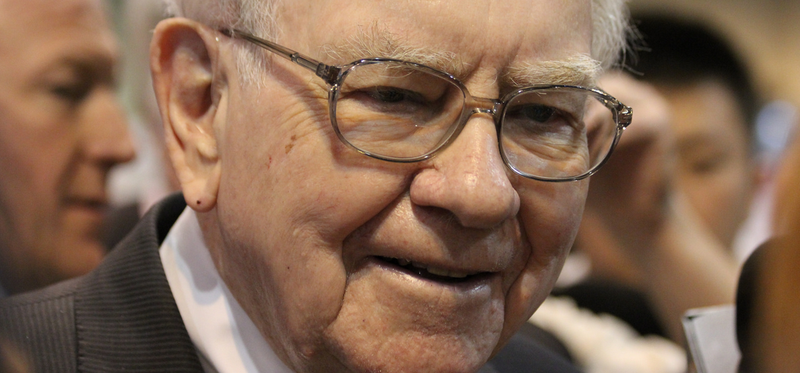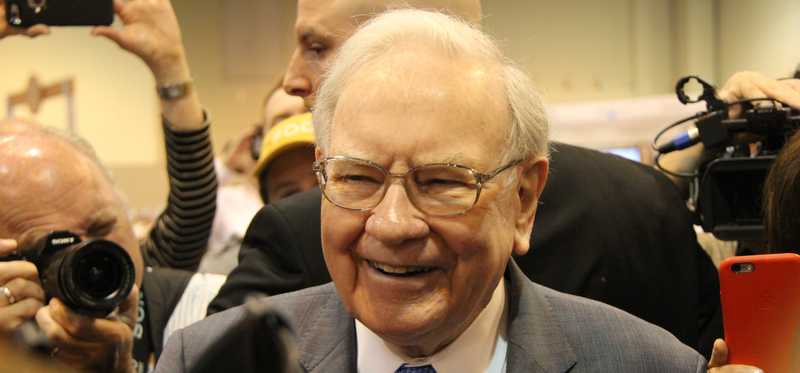23 Ways to Invest More Like Warren Buffett

23 Ways to Invest More Like Warren Buffett
What would Buffett do?
It’s no surprise that Warren Buffett is one of the most
closely followed investors in the world. The Oracle of Omaha has been one of
the most successful investors of all time, and since he took over a struggling
textile company known as Berkshire Hathaway (NYSE: BRK-B)(NYSE: BRK-A)
in the 1960s, a single share of the business has increased more than two
million percent. This means that a $10,000 investment would be worth over
$200 million today
While there’s obviously no way to guarantee yourself results that come close to this, and much of Buffett’s investment strategy is a well-kept secret, there’s a lot we do know about how Buffett invests. With that in mind, here are 23 traits and habits you might want to develop if you want to invest more like Warren Buffett.
ALSO READ: How to invest like Warren Buffett in 2019 and Beyond
Previous
Next

1. Stay the course
The first thing you need to do if you want to invest like
Warren Buffett is to develop a long-term mentality. As Buffett says, "If
you aren't willing to own a stock for 10 years, don't even think about owning
it for 10 minutes."
And, don’t buy stocks because you think the price is going to go up. Buy them because you like the business and think it will do well over time.
Previous
Next

2. …but don’t be afraid to sell
While Buffett is a long-term investor and would prefer to
own all of his stocks forever, even the Oracle of Omaha makes bad choices from
time to time. And when he does, he won’t hesitate to run for the exits. "Should
you find yourself in a chronically leaking boat, energy devoted to changing
vessels is likely to be more productive than energy devoted to patching leaks,"
Buffett has said. In other words, don’t throw more good money into a bad
investment -- if your investment thesis doesn’t pan out, admit that you got it
wrong and move on.
Previous
Next

3. Avoid excessive investment fees
"When trillions of dollars are managed by Wall
Streeters charging high fees, it will usually be the managers who reap outsized
profits, not the clients."
Buffett said this in regards to hedge fund managers, but the same logic applies to high-cost mutual funds and ETFs. It’s quite rare for an actively managed mutual fund to beat the S&P 500 over the long-term. Why? Because the fees the fund charges eat away at your returns year after year, and can have a massive effect over the course of decades.
Previous
Next

4. Avoid complicated investments
You won’t find a lot of tech stocks in Buffett’s portfolio
-- at least in the part for which he makes investment decisions. Buffett
doesn’t understand tech-heavy businesses too well, so he’s not going to try to
evaluate them. (Note: Buffett’s largest investment is Apple, but he thinks of
Apple as more of a consumer goods business these days.)
As Buffett says, "never invest in a business you cannot understand." This is the same reason you won’t find any marijuana stocks in my portfolio -- I think the industry has tremendous potential, but I just don’t know enough to properly evaluate these businesses.
Previous
Next

5. Capital preservation should be a priority
"Rule No. 1 is never lose money. Rule No. 2 is never
forget Rule No. 1” is perhaps the most famous Warren Buffett quote of all time.
To be sure, Buffett isn’t immune from losing money. He has made several major investments that simply didn’t go his way -- just look at Kraft Heinz for a good example.
The point, however, is that capital preservation should be a major priority for investors, and you should make decisions based on how likely an investment is to lose money, not just how much potential it has to grow.
Previous
Next

6. Learn the principles of value investing
Buffett generally practices what’s known as “value
investing,” meaning that his main goal is to buy stocks that are trading for
below their intrinsic value.
While there’s no one specific methodology for doing this, Buffett learned most of his methodologies from legendary value investor Benjamin Graham. Graham’s books The Intelligent Investor and Securities Analysis are excellent reading material for people who want to learn to value stocks like Buffett does.
Previous
Next

7. Identify the competitive advantages before buying a stock
One of the things Buffett looks for when evaluating stocks
is a durable competitive advantage. This can come in many forms -- pricing
power, efficiency, high barriers to entry, etc.
Apple is a good example. As Buffett puts it, Apple has a “sticky” ecosystem -- consumers generally don’t just buy one Apple product, and as a result, people who are Apple customers tend to stay Apple customers.
Previous
Next

8. Find investments with a margin of safety
Another core principle of Buffett’s investing style is to
identify companies with a margin of safety. That is, if things go wrong, you
want the stocks in your portfolio to still trade for less than intrinsic
value. As Buffett puts it:
"On the margin of safety, which means, don't try and drive a 9,800-pound truck over a bridge that says it's, you know, capacity: 10,000 pounds. But go down the road a little bit and find one that says, capacity: 15,000 pounds."
For example, let’s say that a certain stock is trading for $100 a share and your analysis shows that it’s really worth $150. Buffett would see this as a $50 margin of safety -- in other words, the stock’s intrinsic value could drop by $50 and still be attractive.
Previous
Next

9. Invest in what you know well, avoid what you don’t
This is a similar principle to only investing in businesses
you understand, but I’ve always interpreted this as more of a sector-specific
version of the rule. For example, I know bank and real estate stocks very well,
so they make up more than half of my portfolio.
As Buffett says, "You only have to be able to evaluate companies within your circle of competence. The size of that circle is not very important; knowing its boundaries, however, is vital."
Previous
Next

10. Don’t underestimate the value of great management
It’s difficult to over-emphasize the value Buffett places on
great management. Buffett believes that a strong, shareholder-focused
management team adds tremendously to a company’s intrinsic value, and that bad
management can make an otherwise great stock unattractive.
Make sure that you consider management’s track record, specifically when it comes to shareholder-friendly behaviors such as dividend increases and buybacks.
Previous
Next

11. Be greedy when others are fearful…
"Widespread fear is your friend as an investor because
it serves up bargain purchases."
Buffett loves to go shopping for stocks when the market is in panic mode. In fact, some of his best investments have come during the worst economic environments. For example, during the financial crisis when banks seemed to have nowhere to go but down, Buffett invested in Goldman Sachs (NYSE: GS) and ended up making billions in profit.
Previous
Next

12. …and fearful when others are greedy
On the other hand, the worst time to buy stocks is when everyone is convinced they can’t do anything but go up. How appealing did tech stocks look in the late 1990s? It seemed like investing in dot-com stocks was free money -- until it wasn’t.
Buffett’s advice? "Most people get interested in stocks when everyone else is. The time to get interested is when no one else is. You can't buy what is popular and do well."
Previous
Next

13. Don’t let emotions get the best of you
While it’s easy enough to say that we’re going to buy low and sell high, human nature compels us to do the exact opposite. When we see everyone else panicking and running for the exits, instinct tells us to get out as well before things get worse. And when we see everyone else making easy money, that’s when we’re most tempted to throw our money in.
"The most important quality for an investor is temperament, not intellect. You need a temperament that neither derives great pleasure from being with the crowd or against the crowd,” says Buffett. In other words, trust the process. Don’t make emotional decisions based on what the economy or stock market (or your friends) are doing at any given time.
Previous
Next

14. Don’t fear market crashes, but prepare for them
Let’s be perfectly clear -- a market crash is coming. The
only problem is that nobody knows when. It could happen tomorrow, or we could
have several more strong years ahead of us before any significant negative
moves.
However, market crashes are not to be feared. For one thing, if you follow Buffett’s principles such as investing in great businesses and insisting on a margin of safety, you should be well-positioned to make it through the tougher times.
Second, consider the Buffett quote, "Opportunities come infrequently. When it rains gold, put out the bucket, not the thimble." Market crashes serve investors some of the best opportunities, so it’s a good idea to have some spare cash to take advantage. Buffett insists on keeping at least $20 billion on the sidelines at all times (roughly 4% of Berkshire’s market cap), and this is one of the big reasons.
Previous
Next

15. Stop investing in unproductive assets
You won’t see gold or any other precious metals in Buffett’s
portfolio, and there’s a good reason. Buffett likes to invest in productive
assets. Stocks represent businesses, which can produce profits. Bonds produce a
stream of income. Farmland produces crops. You get the idea.
On the other hand, gold and similar assets only have value because you expect that they’ll be worth more in the future. In the meantime, gold costs money to store and insure, but doesn’t generate anything of value. Buffett recently gave a good explanation of why he’s so gold-averse:
"You could take all the gold that's ever been mined, and it would fill a cube 67 feet in each direction. For what it's worth at current gold prices, you could buy -- not some -- all of the farmland in the United States. Plus, you could buy 10 ExxonMobils, plus have $1 trillion of walking-around money. Or you could have a big cube of metal. Which would you take? Which is going to produce more value?"
ALSO READ: Here's What Warren Buffett Just Said About Bitcoin
Previous
Next

16. Do your homework
Investing in stocks requires a few things. You need to build
up the knowledge to evaluate stocks, and you need to have the desire to spend your
own time on a consistent basis to keep up with what’s happening at the
companies you invest in.
And if you have those traits, Buffett thinks stock-picking can be a smart idea. On the other hand, he acknowledges the stock market is not the best place for everyone to put their money -- low-cost index funds are probably best for most investors, according to Buffett.
Previous
Next

17. Learn all you can
How does the most successful investor of all time spend his
days? It may surprise you to learn that Buffett doesn’t have a busy schedule --
he spends most of his time sitting in his office alone and reading. In short,
don’t think that because you’ve read some good books on value investing and you
understand how to evaluate stocks, you’re done learning. Buffett explains it
best when he says that “the most important investment you can make is in
yourself."
Previous
Next

18. Stop paying attention to the noise
To be sure, watching and reading the financial news can be
useful. However, when someone on TV or writing in a newspaper makes a
projection about the direction of the market or an individual stock, take it
with a big grain of salt.
"We've long felt that the only value of stock forecasters is to make fortune tellers look good. Even now, Charlie (Munger) and I continue to believe that short-term market forecasts are poison and should be kept locked up in a safe place, away from children and also from grown-ups who behave in the market like children," says Buffett.
Previous
Next

19. Political headwinds aren’t your problem
When Donald Trump won the 2016 presidential election, there
was much speculation that the outcome would affect Buffett’s investment style.
After all, Buffett is a Democrat and had been an outspoken Hillary Clinton
supporter.
However, Buffett reminded investors that throughout his career, his candidate had lost roughly half the time. There have been a variety of political climates, tax rates, wars, and more, and Berkshire Hathaway (and the overall stock market) has performed quite well. As Buffett advises, "For 240 years it's been a terrible mistake to bet against America, and now is no time to start."
Previous
Next

20. Know that this time is not different
One of the worst things you can hear as an investor is “this
time is different.” Investors heard this during the dot-com bubble, when home
prices were rising dramatically in the mid-2000s, and when cryptocurrencies
were going through the roof in late 2017.
Buffett’s advice: "Keep things simple and don't swing for the fences. When promised quick profits, respond with a quick "no."
Previous
Next

21. Stop worrying about diversification so much
Many investors insist on maintaining a well-diversified
portfolio. According to many investors, there needs to be a certain amount of
money invested in every sector of the market.
Buffett doesn’t buy this logic. He’s very good at evaluating certain industries -- banking and consumer products to name a couple -- and these make up a disproportionally high concentration of Berkshire’s portfolio. And this approach has clearly worked out well for Buffett. "Diversification is a protection against ignorance,” says Buffett. “It makes very little sense for those who know what they're doing."
Previous
Next

22. Never borrow money to invest in stocks
If you’re using margin (borrowed money) to buy stocks and
you want to invest more like Warren Buffett, that’s definitely a habit to drop.
Here’s the problem. Let’s say that you buy $10,000 worth of stock by investing $5,000 of your own money and borrowing $5,000 from your brokerage. If your stock goes up, your gains will certainly be magnified, but what if a market crash happens? If your stock goes down by 50%, you’ll be completely wiped out. "If you're smart, you're going to make a lot of money without borrowing," Buffett says.
Previous
Next

23. Once you’re successful, think about those who aren’t
Now, this isn’t necessarily an investment tip, but is one of
the things Buffett thinks investors who make a lot of money should do.
Buffett is a highly philanthropic individual. In fact, he gives billions of dollars’ worth of Berkshire Hathaway stock to charity every year and plans to eventually give away virtually all of his wealth. As Buffett puts it, "If you're in the luckiest 1% of humanity, you owe it to the rest of humanity to think about the other 99%."
Previous
Next

Investing like Buffett isn’t for everyone
As you have probably noticed, investing like Buffett isn’t
easy. None of these steps are particularly difficult to do, but there’s a lot
that you should consider before buying a stock, and to truly invest like Warren
Buffett, you need the time, knowledge, and desire to do it correctly.
Matthew Frankel, CFP owns shares of Apple and Berkshire Hathaway (B shares). The Motley Fool has no position in any of the stocks mentioned. The Motley Fool has a disclosure policy.
Previous
Next
Invest Smarter with The Motley Fool
Join Over Half a Million Premium Members Receiving…
- New Stock Picks Each Month
- Detailed Analysis of Companies
- Model Portfolios
- Live Streaming During Market Hours
- And Much More
READ MORE
HOW THE MOTLEY FOOL CAN HELP YOU
-
Premium Investing Guidance
Market beating stocks from our award-winning service
-
The Daily Upside Newsletter
Investment news and high-quality insights delivered straight to your inbox
-
Get Started Investing
You can do it. Successful investing in just a few steps
-
Win at Retirement
Secrets and strategies for the post-work life you want.
-
Find a Broker
Find the right brokerage account for you.
-
Listen to our Podcasts
Hear our experts take on stocks, the market, and how to invest.
Premium Investing Services
Invest better with The Motley Fool. Get stock recommendations, portfolio guidance, and more from The Motley Fool's premium services.